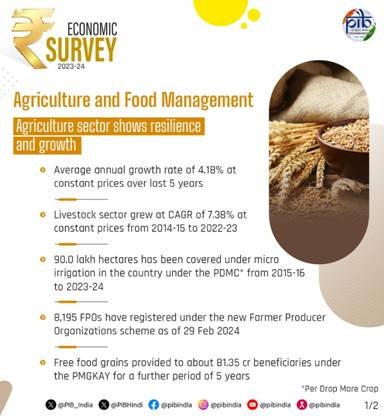Allied sectors of agriculture emerged as promising sources to improve farm income: Economic survey
Livestock sector grows at CAGR of 7.38 per cent; fisheries sector grows at 8.9 per cent between 2014- 15 and 2022-23.
Economic Survey 2023-24 was presented in the Parliament today by Union Finance and Corporate Affairs Minister Nirmala Sitharaman. Economic Survey shows that the allied sectors of Indian agriculture are steadily emerging as robust growth centres and promising sources for improving farm incomes. From 2014-15 to 2022-23, the livestock sector grew at an impressive Compound Annual Growth Rate (CAGR) of 7.38 per cent at constant prices. The contribution of livestock to the total GVA (at constant prices) in agriculture and allied sectors increased from 24.32 per cent in 2014-15 to 30.38 per cent in 2022-23. In 2022-23, the livestock sector contributed 4.66 per cent of the total GVA, significantly boosting the per capita availability of milk, eggs, and meat. The fisheries sector, a crucial contributor to the Indian economy, makes up about 6.72 per cent of the agricultural GVA and has grown at compound annual rate of 8.9 per cent between 2014-15 and 2022-23 (at constant prices). This “sunrise sector” supports approximately 30 million people, particularly marginalised and vulnerable communities.
Economic Survey states that the Animal Husbandry Infrastructure Development Fund (AHIDF) facilitates investments from individual entrepreneurs, private companies, FPOs, and Section 8 companies and Diary Cooperative (included by merging Dairy Processing and Infrastructure Development Fund in AHIDF) in key areas like dairy processing, meat processing, animal feed plants, and breed improvement technology. The government provides a 3 per cent interest subvention to the borrower and a credit guarantee of up to 25 per cent of total borrowing. As of May 2024, 408 projects have been sanctioned by the lending banks/ NABARD/NDDB worth Rs 13.861 Crore, generating 40,000 direct employment opportunities and benefiting more than 42 lakh farmers.
Economic Survey stated that in 2022-23, India achieved a record fish production of 17.54 million tons, ranking third globally and accounting for 8 per cent of global production. To bolster this sector, a comprehensive intervention has been developed in the form of Pradhan Mantri Matsya Sampada Yojana (PMMSY) with the objective to enhance seed and fish production and other extension services. To address the sector’s infrastructure needs, the Fisheries and Aquaculture Infrastructure Development Fund (FIDF) was introduced in 2018-19 with a total fund size of Rs 7.52 thousand Crore. So far, 121 proposals have been recommended for Rs 5.59 thousand Crore as a concessional rate.
Food Processing Sector:
As per Economic Survey, India is the largest producer of milk and the second largest producer of fruits, vegetables and sugar. The food processing industry in India is one of the largest employers in organized manufacturing, with a 12.02 per cent share in the total employment in the organised sector. The value of agri-food exports, including processed food exports during 2022-23, was USD46.44Billion, accounting for about 11.7 per cent of India’s total exports. The share of processed food exports also increased from 14.9 per cent in 2017-18 to 23.4 percent in 2022-23.
Economic Survey highlights that the GVA in the food processing sector has increased from ₹1.30 lakh crore in 2013-14 to Rs 1.92 lakh crore in 2022-23. The sector constituted 7.66 per cent of GVA in Manufacturing in 2022-23 at 2011-12 prices.
Livestock sector grows at CAGR of 7.38

